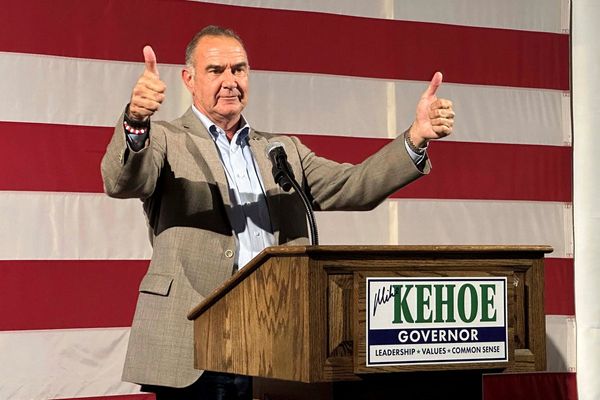
It is no small irony that the first U.S. presidential candidate in history to run a socially distanced campaign, Joe Biden, mostly practises distancing from social media. He hasn’t generated the fanatical digital following de rigueur for modern politicians. He’s revealed precious little about his tech intent even as he inherits not one but two antitrust lawsuits against major tech companies. And he even picked a vice president with Silicon Valley connections, but not necessarily for her technology chops.
As president-elect, Biden may not be showing much love for tech, but the tech-obsessed like to speculate about what’s on his mind for the sector by parsing the occasional quote on hot-button issues: antitrust (the non-committal: “Something we should take a really hard look at”); legal immunity for platforms from content posted on them (the impractical: “Should be revoked, immediately”); Big Tech bigwigs (the ho-hum: “Not everyone in the tech industry is a bad guy,” or the overly specific: “Little creeps”).
Such speculation chases the wrong question, though. Technology is a means—albeit a very potent one—to ends. Policy priorities should follow that logic. The goal ought to be getting Biden to fall in love with technology by focusing on the “ends,” in particular: the answers to two questions. First, how does technology contribute to the challenges in the Biden-Harris priority areas? Second, how can technology policy solve problems and, therefore, what tech-related actions should the administration consider in its first 100 days?
Biden-Harris are taking over at a tumultuous time. The transition team has narrowed its focus to a shortlist: COVID, the economy, race, and climate. Although it appears that technology policy didn’t make the cut, it is central to each.
Besides being a public health, humanitarian, and economic crisis, COVID-19 is an unparalleled information crisis. Given all the unknowns—with fresh uncertainties accompanying the vaccine—the pandemic is a perfect incubator for an infodemic: a flood of information and misinformation on the pandemic.
Existing information ecosystems were lifesavers in facilitating social distancing. But the pandemic revealed many gaps. For one, pandemic resilience varies widely across the United States. Not only is each state managing its own response in its own way, the states vary in their digital readiness, a measure my research team at The Fletcher School at Tufts created to evaluate each state’s potential to maintain work and life continuity through the pandemic using technology. We found a strong correlation between digital readiness and the effectiveness of the state’s COVID response.
Our research also reveals that disparities in internet access, combined with uneven policies, hamper post-pandemic healthcare. States such as New Mexico, Montana, and Iowa expanded their telehealth policies, essential during social distancing, but they have poor internet access, which limits the effectiveness of such services. Other states, such as North Carolina, Georgia, and Florida have better internet access, but had no telehealth policy expansions. Still others, such as West Virginia, Arkansas, Indiana were weak on both fronts.
Nationwide, the United States lags behind global benchmarks in the provision of public services online, essential for post-pandemic survival. Our research team evaluated 42 countries on digital public services availability and found half of them did better than the United States. In the case of using digital technologies for COVID management, including for contact tracing and exposure identification, the United States performed particularly poorly. Public authorities grossly mismanaged COVID health and testing data collection and reporting. And there is no national plan to improve data collection or intervene in the predictable cyberattacks and vaccine-related misinformation campaigns even as the first vaccines are being rolled out
On the economy, Biden has expressed skepticism about whether the technology industry produces “good-paying jobs.” The industry has a chance of earning some love if the Biden team were to dig into the data: Technology accounted for 6.9 percent of U.S. GDP and grew 4.3 times faster than the economy overall during 1997-2017; according to the industry’s analysis, it is behind only manufacturing and government in contributing to GDP and it employed 7.7 percent of the U.S. workforce. Each congressional district in the country averages over 400 tech startups, or about 3,400 jobs. Also, our research shows, the sector helped cushion the negative economic impact due to the pandemic. But there are areas of deep concern.
First, broadband access in the United States—key to digital readiness—is among the most expensive in the world. Vast parts of the country are so-called broadband deserts and they aren’t just in rural areas; three times as many metropolitan households as rural households lack broadband subscriptions. Major cities, such as Detroit, Philadelphia, and Cleveland, have discriminatory broadband access. Inhabitants of such deserts suffer from longer periods of unemployment; tellingly, of the 10 states with more than 30 percent of the workforce filing for unemployment between March and mid-May, only two score well in our measure of digital readiness.
Second, for many firms, it seems that much of the digital migration of 2020 is here for the long haul. The U.S. internet infrastructure needs upgrading to remain globally competitive and support a robust economic recovery. While the internet did hold up through the pandemic, the digital infrastructure was severely stressed. Almost 90 out of the most populous cities critical to American productivity experienced a network slowdown when remote working spiked. San Jose, New York, Austin, Charlotte, Washington, D.C., and Houston experienced a 24-44 percent decline in internet speed. Despite significant improvements in internet speeds this year, major U.S. cities lag behind European counterparts.
Day-to-day lives were disrupted by the pandemic, and the digital disparities had a severe impact; schooling is a powerful example. Parents’ productivity drops as they struggle to preserve continuity of their children’s education, and a poorly educated child is a less productive adult. Over 55 million students were affected by schools moving online due to COVID, while 17 million children were without internet access. Schools resorted to mobile hot spots or repurposing old school buses as mobile Wi-Fi to connect students in broadband deserts. To make matters worse, the less digitally ready states are also the ones with greater challenges in controlling the pandemic and had no recourse but online schooling.
Next, on race, the historic racial inequalities that boiled over during the summer of 2020, are reinforced by several digital inequalities. There are wide gaps between the proportions of white, Black, and Hispanic households with broadband internet—with a 14 point gap in broadband access between white and Black households with school-going children, and a 12 point gap between white and Hispanic households.
Black households likewise have lower access to digital-economy jobs, and as such, are underrepresented in higher-pay, technology enabled occupations . Seventy percent of Blacks and 60 percent of Hispanics report being underprepared with digital skills, affecting their employability. While a third of all white workers in 2018 were in jobs they could do from home, less than 20 percent of Black workers and only 16 percent of Hispanic workers were in jobs that could be done remotely. Increasing automation, accelerated by a socially distanced economy, means the majority of Blacks and Hispanics could be locked out of 86 percent of jobs by 2045.
Digital disparities lead to other disparities. Black communities are disproportionately affected by the pandemic and the economic downturn. An overwhelming majority of states had a higher Black out-of-work population, relative to the state average. Black workers have lower access to digital public services (for example, for filing for unemployment insurance online or accessing relief checks), worse telehealth coverage, and lower access to financial instruments.
Finally, climate and the technology sector are closely tied; the sector is key to America’s climate challenges. For one, the industry is a heavy user of electricity and water, especially for data centers and the demands on such centers are growing dramatically. Companies, such as Amazon have a ballooning environmental footprint with their growing network of trucking, shipping, and packaging. Meanwhile, a smartphone alone consists of plastics, ceramics, and 62 different types of metals—16 out of the 17 rare earth metals.
Climate denial is a major obstacle to action on climate issues—and social-media platforms are the most powerful disseminators of disinformation on climate science. Platforms such as Facebook are focused on rooting out disinformation constituting immediate threats to human lives, health, and safety. But climate-change content frequently appears in the form of opinion, which Facebook is reluctant to remove from its platform.
Considering the many ways in which technology gaps are intertwined in the Biden-Harris priorities, here are three actions for the administration’s first 100 days—the first steps towards a technology-policy agenda.
First, the incoming administration should work with state governments to identify gaps at the local levels. American digital readiness varies widely by state. The federal government can set a nationwide framework, policy guidelines, secure budgets, and incentives, but the barriers to digital readiness and solutions must be identified at a state and local level. This will require collaboration with governors and local political and business leaders. The Biden administration needs to facilitate a process for identifying gaps, setting targets, and creating a plan to close them for each state, including near-term fixes and a longer-term roadmap.
Each state has different issues. Some, such as Arkansas, Kentucky, Mississippi, New Mexico, Alabama, and West Virginia, with less than a third of their populations with basic broadband access, should be prioritized for access. Others, such as Wisconsin, North Carolina, and Nebraska have seen political resistance to solutions such as municipal broadband; new politically feasible strategies must be devised here. Still others lack a broadband strategy entirely, for example Michigan, Minnesota, and New Hampshire.
States must be given targets, with incentives to hit them. As examples, consider two states at the bottom of the digital readiness measures. Arkansas, with the lowest terrestrial broadband coverage, must improve coverage by 28.2 percent to reach the current national average. Louisiana, with among the lowest spending per pupil in the country, must increase spending by 11.8 percent to reach the current national average. Its proportion of households with computer/laptop access and internet access is low; it must improve these proportions by 4.2 percent and 6.9 percent, respectively, to reach the current national average.
Second, now that antitrust action is bearing down on the major tech companies, Biden and Harris should use their negotiating leverage with Big Tech to address the gaps in all priority areas. Closing the digital gaps is key to achieving all their priorities, but it can be hard to execute. Coordinating with multiple state officials is complex and political, and each state has a different competitive, legal, and consumer context; the digital inequalities across racial lines add to the complexity. Moreover, there are several technology options for gap-closing in both the near and long term.
But there is rare bipartisan consensus on the issue of reining in the power of Big Tech. Biden hasn’t commented on how he intends to move forward on the antitrust or tech regulation agenda. But his silence is an opportunity. The Biden administration can use its leverage to ensure that Big Tech becomes an ally in closing key gaps in the priority areas. It can help close parts of the digital access gap, since the major players have the capabilities to provide internet access, as outlined in an earlier article. Big Tech companies also have expertise in key aspects of any COVID-19 and vaccine-management plan. Google and Apple developed exposure identification technologies used worldwide, albeit with mixed results. Google, Facebook, and Twitter are key to reliable information dissemination and rooting out misinformation. Amazon is key to logistics and distribution. All are masters of data capture, analysis and management. Google also has access to medical records across three-quarters of the states. If deployed intelligently, with integrity and oversight, these world-class capabilities can be revolutionary in supporting the enormously complex task of prioritizing and tracking who gets the vaccine and for executing the rollout in an equitable and scientifically rational manner. Thus far, the vaccine rollout is not going well. It would be a loss to ignore capabilities in our own backyard that could turn this pathetic track record around; Biden cannot afford to have the COVID mismanagement of 2020 graduate to the COVID-plus-vaccine mismanagement of 2021.
Third, the surge in remote working creates an opportunity to take small but meaningful steps towards closing racial inequalities. The tech industry can address its long-standing issues with diversity in its ranks by hiring from regions with deeper pools of diverse talent outside the traditional tech clusters. States such as Georgia, Texas, Delaware, Virginia, and Maryland offer such opportunities. Such hiring practices, if encouraged by the Biden team, will catalyze firms in other industries to follow suit.
On climate issues, the technology industry is already leading with zero-carbon commitments and are among the leading investors in clean-energy startups. This can provide momentum across the U.S. economy and act as a role model for other sectors, given the industry’s visibility and influence. Microsoft committed to carbon-negativity. By 2030, Google plans to run on carbon-free power and Apple announced plans for net-zero climate impact. Amazon pledged carbon neutrality by 2040 and Facebook plans on 100 percent renewable-energy usage. The industry should be key to a Biden strategy to make up for lost time on meeting the Paris climate commitments.
Candidate Biden touted a $20 billion budget for rural broadband infrastructure; this budget is too low for many reasons. It does not address the even greater gaps in metropolitan areas. The number of Americans without broadband is much larger than the 21 million FCC estimate the Biden team uses for its budgeting. Microsoft suggests that 162.8 million Americans could not access the internet at broadband speeds in 2019. Even the definition of broadband needs an upgrade; average download speeds in other developed countries—Japan (102.38 Mbps), Luxembourg (375.78 Mbps), or South Korea (86.98 Mbps)—put the American 55.07 Mbps to shame. With Democrats adding to their presence in the Senate, as the trends in the Georgia runoff elections suggest at time of writing, Biden must upgrade his paltry proposed budget of $20 billion and prepare a much better-informed data-driven understanding of the digital divide, make a compelling case before Congress and execute on a bold digital strategy.
As for hot-button tech issues—antitrust, platform immunity, data privacy, AI, 5G, and China—they must all be on the longer-term agenda. But it is worth beginning with the pressing needs where technology is an essential lever for change. This is an opportunity to recognize that the internet is essential for transformations that cut across health, economy, race, and climate. As the country that gave the world digital technology, it is time for the United States to put that technology to work. What’s not for Biden to love about that idea?







